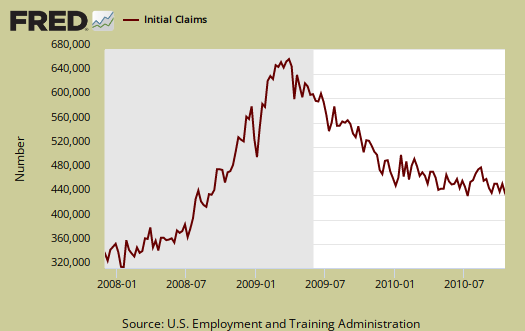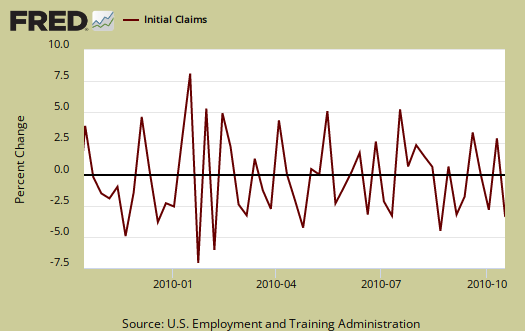Initial weekly unemployment claims is a volatile number and subject to revisions. We have shown that initial unemployment claims are simply not dropping, instead acting like a yo-yo, hovering above 450,000. This week is no exception.

From the jobless claims report:
Seasonally adjusted initial claims was 452,000, a decrease of 23,000 from the previous week's revised figure of 475,000. The 4-week moving average was 458,000, a decrease of 4,250 from the previous week's revised average of 462,250
That said, this is the release from the previous week:
In the week ending Oct. 9, the advance figure for seasonally adjusted initial claims was 462,000, an increase of 13,000 from the previous week's revised figure of 449,000. The 4-week moving average was 459,000, an increase of 2,250 from the previous week's revised average of 456,750.
As one can see, last week's numbers were revised +13,000, comparing the previous week numbers to this advance, one gets a headline buzz of an 23,000 drop. Yet comparing advance reports, without revisions, the drop is 10,000. This is just comparing two weeks of reports. Also notice how last week's number's were revised upward, which is almost always the case. Don't think this is a grand conspiracy, more, the data dribbles in to the Department of Labor, not in time for the original advance report press release.
Below is the mathematical log of initial weekly unemployment claims, so one can get a better sense of the rise and fall of the numbers. A log helps remove some statistical noise, it's kind of an averaging. As we can see we have a step rise during the height of the recession, but then a leveling, not a similar decline. We have this yo-yo bobblehead, over 400,000, never ending labor malaise. This does not bode well for any sort of real recovery, which must include jobs.

Below is a graph of the percent change in initial weekly unemployment claims for the last year. Look at how the numbers change bobs around zero, up and down, like a yo-yo. In other words, as a pattern, the numbers are simply not dropping.

Below is the 4 week moving average, also set to logs to remove even more statistical noise, for the last year. Here too one can see this yo-yo affect above 455,000, just bobbing up and down, no steady decline! Also note the 4 week average has been lower this recession, so once again, one must take the long view on this labor economic metric.

Bottom line, initial weekly claims needs to have a declining slope, a larger rate of change, and needs to go below 400,000. Why it isn't at this point, is a good question. Surely everyone in America has been fired at least once by now.

Recent comments